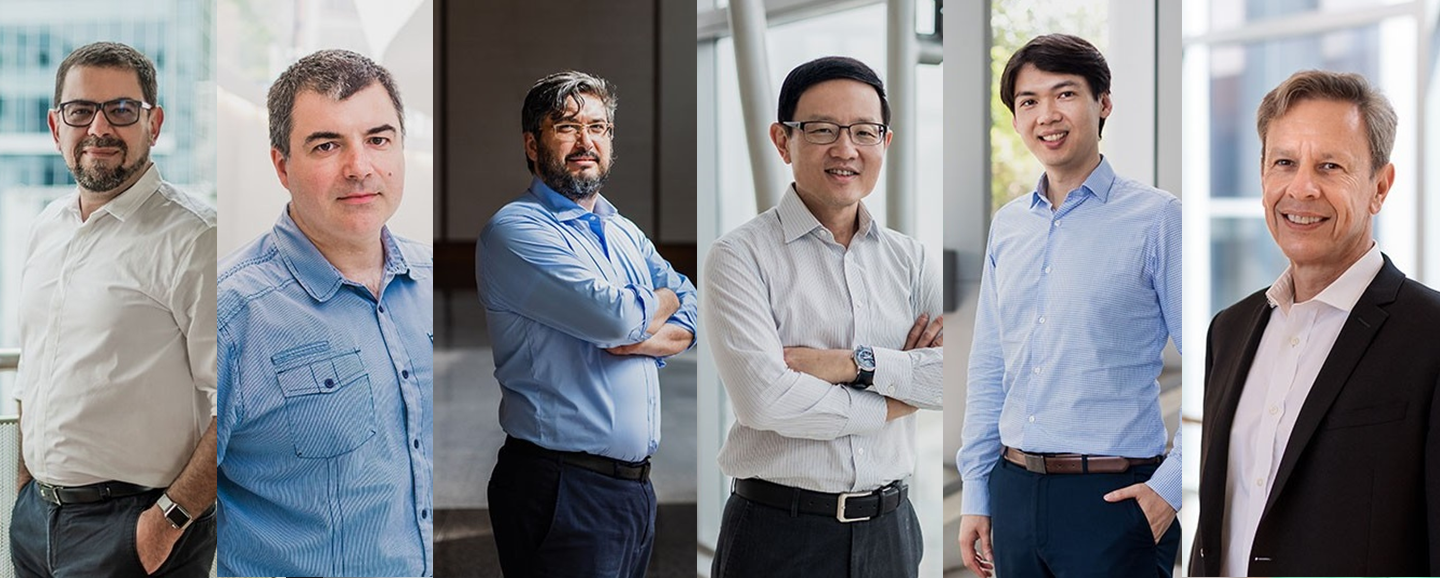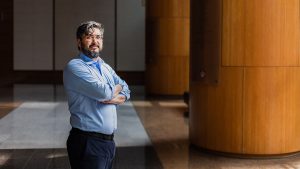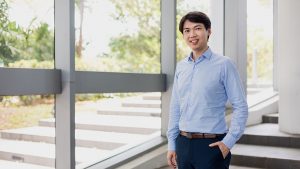World-leading material research in NUS!

In the Nature Index 2021 Materials Science supplement published on 30 June 2021, NUS was placed 7th in the world for its materials science research output. This prestigious supplement examines how researchers are rethinking the nature and potential of materials to drive advances in manufacturing, drug discovery, product design, and more. NUS is the only university from Singapore in the Top 10 of the Index.
We highlight a selection of the pioneering scientists of CA2DM and their innovative research.
Professor Antonio Castro Neto


Professor Castro Neto is interested in the synthesis, characterisation and creation of new devices based on 2D materials. In addition to 2D materials he is also an expert in strongly correlated materials and disordered magnetic systems
A pioneer in the field of atomically thin materials is Professor Antonio Castro Neto, Director of the NUS Centre for Advanced 2D Materials (CA2DM). The CA2DM was established in 2010 for the conception, characterisation, theoretical modelling and development of transformative technologies based on 2D crystals, such as graphene.
Prof Castro Neto, who is also a Distinguished Professor at NUS Physics and NUS Materials Science and Engineering, as well as a faculty member at NUS Electrical and Computer Engineering, is an expert in all aspects of graphene. He further described the unique advantages that 2D materials offer, “They have physical and chemical properties that normal three-dimensional materials do not have — such as extreme quantum behaviour. Meaning the electrons in these materials behave like waves, not particles.”
These extreme quantum behaviours could create the next generation of electronic components with revolutionary capabilities, and 2D materials like graphene are already being used in the development of quantum computers.
“New materials are the basis for the Industry 4.0,” said Prof Castro Neto, explaining the importance of materials research. “Advances in nanotechnology, biotechnology, quantum computing, artificial intelligence, 3D printing and the Internet of Things (IoT) all require new materials. These new materials then impact fundamental areas such as electronics, food, water, the environment, energy and more,” he stated.
He recently led a team to create a new class of intelligent materials that has the structure of a 2D material, but behaves like an electrolyte. Known as “2D-electrolytes”, the materials could open up a new way to deliver drugs within the body as well as other exciting applications. The results were published in Advanced Materials on 12 May 2021.
Professor Kostya Novoselov

Professor Novoselov is a Nobel Prize-winning scientist, specialising in the areas of condensed matter physics, mesoscopic physics and nanotechnology. One of his latest research interests is the design and synthesis of new functional intelligent materials inspired by the natural operation of living organisms
One of the most important materials research advances of the 21st century was the isolation of graphene — the world’s first two-dimensional (2D) material. Since this breakthrough, research into 2D materials has flourished, and ground-breaking applications have emerged in areas such as photovoltaics, semiconductors, electrodes and water purification.
The discovery of 2D materials is co-credited to Professor Sir Konstantin Novoselov jointly with Professor Sir Andre Geim and the pair were awarded the 2010 Nobel Prize in Physics for this immense achievement. Prof Novoselov is now the Tan Chin Tuan Centennial Professor at NUS Materials Science and Engineering and continues to investigate this rich research area.
At just one atom thick, 2D materials are as thin as materials can possibly be, and today, approximately 700 stable 2D materials have been predicted, with many remaining to be synthesised. Of this vast range, “Different 2D materials hold different properties. They can be metals, semiconductors, superconductors, ferromagnets, and more,” Prof Novoselov explained.
This range of remarkable properties mean that 2D materials can be applied in numerous areas. “Our 2D materials are being used for a variety of applications, from energy solutions to composite materials, from printable electronics to optoelectronics,” he said. What’s more, Prof Novoselov’s latest research combines 2D materials and the principles which govern living matter, to develop new functional intelligent materials with bespoke properties. These bio-inspired materials could have applications in everything from artificial neural networks to smart membranes.
Professor Barbaros Özyilmaz

Professor Özyilmaz’s research interests range from fundamental studies of spin, charge and phonon transport in 2D materials, to the development and facilitation of 2D materials such as graphene in biomedical and energy storage applications
Among his many research interests, the Head of NUS Materials Science and Engineering, Professor Barbaros Özyilmaz, is focussed on accelerating the widespread adoption of graphene and other 2D materials into industry.
2D materials can generally be described as perfect crystals of atoms regularly spaced in an atomically thin sheet. While this fundamental structure gives 2D materials their incredible electrical and mechanical properties, it currently makes them costly and tricky to scale up for many industrial applications. Therefore Prof Özyilmaz, who is also from NUS Physics and CA2DM, investigates how to make 2D materials more robust.
Through his cutting-edge research, Prof Özyilmaz recently discovered that 2D materials could be synthesised in such a way that they are amorphous films rather than crystals. These amorphous 2D films still have some of the desirable properties of crystalline 2D materials, but are much more hardy, and cheaper to make. “Our amorphous films can be synthesised at much lower temperatures because they don’t need to be perfect in terms of the crystal structure,” Prof Özyilmaz said.
This breakthrough is a leap forward in making 2D materials generally viable for industrial applications. “These amorphous films focus on a subset of 2D material properties, and sacrifice the rest, to ensure that they are more scalable, processible and manageable in terms of risk for industry,” Prof Özyilmaz explained. This novel discovery was published in the journal Nature last year, and is of great interest to many companies by providing a shortcut to the commercialisation of graphene.
Professor Lim Chwee Teck

Professor Lim works with an interdisciplinary team of engineers, biologists and clinicians to address important scientific and biomedical problems relating to human diseases. In particular, he conducts mechanobiology research on diseases associated with cancer, malaria and bacterial infection so as to provide new insights and to better understand their pathophysiology
Another world-leader in the field of biomedicine is Professor Lim Chwee Teck, Director of the iHealthTech, who is also NUS Society Chair Professor at NUS Biomedical Engineering.
“It is known that cancer cells can change their biophysical properties, resulting in them being more deformable and less adhesive. These changes are significant and can lead to cancer metastasis, severe pathology and eventual death,” Prof Lim said.
Hence, using micro- and nanomechanical tools, he investigates why and how such biomechanical changes can occur in circulating cancer cells, so as to better understand their contributions towards metastasis — the main cause of death in patients. He hopes that such research will not only lead to the design of more effective technologies in the detection and diagnosis of cancer, but also better strategies in combatting this disease.
In fact, based on his research findings, Prof Lim has developed a microfluidic cancer biochip which can detect and isolate circulating tumour cells from peripheral blood of patients (known as liquid biopsy). This technology has since been commercialised by Biolidics Limited, which obtained an FDA listing in USA and China, and is being used in over 90 locations around the world.
Earlier this year, he led a research team to develop a technique that uses artificial intelligence to determine whether a single cell is healthy or cancerous by analysing its pH. Each cancer test can be completed in under 35 minutes, and single cells can be classified with an accuracy rate of more than 95 per cent. The work was first published in the journal APL Bioengineering on 16 March 2021.
President’s Assistant Professor Benjamin Tee

President’s Assistant Professor Tee’s research focusses on exploiting novel materials and fabrication techniques to create new flexible and stretchable electronic sensor devices. These devices can be used in a variety of applications from human-machine interfaces to biomedical uses
The area of biomedicine is one which relies on the regular development of new materials. A widely recognised innovator in this field is President’s Assistant Professor Benjamin Tee from NUS Materials Science and Engineering. His current research is advancing state-of-the-art smart electronic skin materials that can sense the environment.
Being able to sense environmental changes in pressure, temperature and humidity is a natural ability all humans have, but it is much more difficult for machines to do that today. “Our skin is naturally ultra-robust, and adaptive to many different environmental conditions. In contrast, most materials do not have such flexibility, as many sensor materials are made from brittle elements such as silicon or metals,” explained Asst Prof Tee, who is also from NUS Electrical and Computer Engineering, and NUS Institute for Health Innovation & Technology (iHealthtech). Therefore, he is exploring and developing new flexible, stretchable materials that can also provide more robust sensing capabilities.
In addition, these flexible ‘electronic skins’ can self-heal, just like real skin. This autonomous self-repair capability provides a new way for electronic devices to withstand damage. “If your mobile phone screen is made of self-repairable materials, you will not need to find a repair shop and risk exposing your data after dropping your phone on the rock hard pavement, because the cracked screen will magically heal itself,” Asst Prof Tee said.
His research in electronic skins will also enable better prosthetic devices that are sensitive to the environment. This could reduce the phantom limb pain associated with limb loss, and the prosthetic devices would feel more natural and intelligent. “This can help patients regain normal lives and regain their mobility and confidence,” Asst Prof Tee stated.
He recently led a team to develop a new material known as artificially innervated foam, or AiFoam, which can mimic the human sense of touch, sense nearby objects without actually touching, and repair itself when damaged.
Professor Gui Bazan

Professor Bazan investigates composite materials which contain living organisms. These biocomposites consist of microorganisms and a polymeric matrix with metallic properties
In addition to biomedical devices, another major area of exploration in materials that is of global interest are living composite materials. Composites consist of two or more different material types brought together to provide physical properties otherwise unattainable with individual components. Professor Gui Bazan, who is Provost’s Chair Professor at NUS Chemistry, conducts innovative research in this area.
“Ever since straw or rice husks were added to mud bricks to make them more robust over 7000 years ago, humans have been aware of composite materials,” Prof Bazan stated. But despite this history, there are very few examples of composites where living systems are considered an essential element. Prof Bazan explained this is why he is blazing a trail in this research area. “Our group is thus pioneering living ‘biocomposites’ containing microorganisms and a polymeric hydrogel matrix with metallic properties,” he said.
Prof Bazan’s research coordinates principles from chemical synthesis, materials engineering, soft electronic matter and electromicrobiology. It lays the foundation for promoting and understanding electronic communication between synthetic elements and microbial communities. “Living microbial biocomposites provide us with a unique opportunity to harness the extraordinary diversity and adaptability of bacteria,” he described.
With this approach Prof Bazan explained that, “It is possible with the right biotic/abiotic combination to use the bacteria for converting chemical energy (in other words its food) into electrical current at levels that are not attainable by any other way.” Given time, this may reveal the possibility to use wastewater as the food source and let the bacteria remove organic contaminants, while at the same time produce electrical power for a green source of energy.
Materials research is not only one of the most rapidly evolving and fastest growing scientific disciplines, but also one which stands at the forefront of modern technology, spanning every facet of 21st century life. The team of first-rate researchers collected at NUS is revealing brand new research insights and spearheading novel applications in all aspects of this field. Ultimately, the cutting-edge materials research conducted at NUS will have far-reaching societal benefits in Singapore and globally.
Source: NUS News

